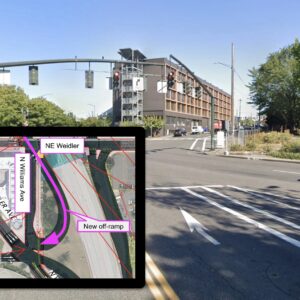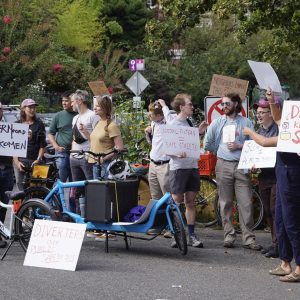Official Bureau of Transportation committees that represent two of the groups TriMet is trying to keep safe from MAX trains on the new Orange Line — people who walk and bike — oppose the agency’s plan to use swing gates at the entry and exit of tracks at two intersections in inner southeast Portland.
After hearing about plans for the path at SE 8th and 11th, the City of Portland’s Bicycle Advisory Committee and Pedestrian Advisory Committee have both issued formal letters of opposition to TriMet.
The bicycle committee outlined several reasons for their disapproval. The main reason is, “the operating difficulties they will impose on members of the traveling public – principally those who are bicycling or walking.”
Here’s more from their letter:
“As you heard at the BAC [Bicycle Advisory Committee] meeting, these swing gates pose difficulties for those using non-standard (but not uncommon) bicycles. These include cargo bikes, especially front loading cargo bikes used to transport children. They also include tricycles, and recumbent bicycles. The population using these bikes, especially the latter two types, often include seniors and others who may be experiencing physical challenges that make it difficult for them to operate a standard bicycle. The swing gates will make it awkward, if not impossible to proceed through the area while sitting on the bicycle itself. The difficulties of people bicycling and dismounting and then pushing their bikes through the gates is unknown at this point as that has not been tested. We are concerned about this particularly at 8th Avenue which is part of the routing for one of the city’s planned Major City Bikeways along an alignment that generally follows 9th Avenue.”
Advertisement
Both the BAC and the Pedestrian Advisory Committee also expressed serious concerns about mobility issues the gates would present to people with severe disabilities. When a BAC member asked TriMet what would happen if a quadriplegic tried to use the gates, committee Chair Ian Stude says that input was, “simply dismissed by [TriMet] staff.”
The Pedestrian Advisory Committee (PAC) said they oppose swing gates because they, “would be very difficult if not impossible for people with disabilities to use.”
For their part, TriMet does appear to have modified their proposal after the BAC meeting on July 14th. When they brought the plans to the PAC on the 21st, they had made some revisions. According to someone who was at that meeting, TriMet is now considering using “switchback” type crossings at SE 8th. These crossings are common on current MAX lines on N Interstate Avenue and E Burnside. They require people to make a sharp zig-zag turn prior to entering and exiting the tracks.
In a statement last week, TriMet said they’re “continuing to work on alternatives that respond to the feedback we’ve received from the community, our partners and from our safety and security team.” The agency expects to announce next steps by the end of this month.







Thanks for reading.
BikePortland has served this community with independent community journalism since 2005. We rely on subscriptions from readers like you to survive. Your financial support is vital in keeping this valuable resource alive and well.
Please subscribe today to strengthen and expand our work.
Good. Hopefully, TriMet does the sensible thing and instead installs automatic gate arms similar to those that already exist on the road.
Article states that they’re instead looking at “switchback” gates which are like extra awkward chicanes. I don’t see how these will be any better for those on hand-crank trikes or front-load cargo bikes.
Agreed. The only solutions that make sense IMO are automatic gates or overcrossings.
Have we actually had any reasoning of why these aren’t going to be used (or apparently discussed)? They use them elsewhere in the city for both bikes and cars.
Glad TriMet (might) be paying attention to suggestions made via Twitter: https://twitter.com/pdxblake/status/621820490789711872
The zig-zags aren’t as bad as the gates, but I still don’t see a cargo bike/trike carrying kids or a long recumbent making it through those narrow right-angle corners, especially when there’s anyone else trying to get through in the other direction.
I ride my tag along equipped tandem(about 10 feet long) with about 150 pounds of kids astride through the ‘zig zag’ crossings on interstate all the time. easy as pie.
D.
The zig-zags are still a downgrade to access for walking and bicycling, making routes longer. Every little detour and zig-zag increases travel time.
The difference between how TriMet handles motorized and non-motorized traffic is significant.
People driving cars are given dedicated lanes, preferential right-of-way when crossing bus routes, and safety barriers that automatically open and close, despite the high cost of such things. TriMet also conducts drills to train operators how to manage when someone drives onto the tracks.
TriMet does none of this for non-motorized transportation. For people walking and bicycling, TriMet spends considerable money to pay people to hands out fliers all along the Orange Line to remind the public that it (TriMet) is not responsible for the public’s safety and that the burden of safety rests with people using sidewalks, despite Oregon’s laws to the contrary. TriMet puts up physical barriers blocking sidewalks and bikeways, diverting non-motorized traffic on and off roadways, into and out of space shared with speeding cars. They install contradictory signs that conflict and don’t clearly state where people should walk or ride. One bicycle signal along the Orange Line, the one you see when traveling west across 11th & 12th, actually turns green when cross traffic is still moving, placing people in great danger if they have even a brief moment of confusion at that intersection. The stop sign they installed on the crosswalk near Caruthers & 8th Avenue contradicts Oregon’s crosswalk laws and gives the false impression that bus operators have priority there.
Sidewalks, pedestrian bridges, and bicycle lanes are still slowly coming on line and are being manipulated and adjusted, months after motorized traffic has had clear sailing through the area. Many of the bicycle and pedestrian facilities along the Orange Line seem haphazardly designed. Many use outdated, unsafe street designs and some are completely invented – not appearing in any engineering or legal texts – to impede people walking and bicycling so that people driving don’t have to bother looking out for other people’s safety. Other facilities, like the painted bike lane “buffer” on SE 17th, have already been destroyed by motor vehicle damage.
I’m thankful the Orange Line provides some limited pockets of space where I can get safely away from people driving cars, but on the whole the trail is a mess and an embarrassment to Portland as we try to claw our way back to our status as a great city for walking & bicycling. It’s a shame we don’t have a group strong enough to demand the City & TriMet design & build world-class bicycle facilities.
^ Somebody is angling for a comment of the week. 😉
What is the cost going to be for automatic gates compared to swing gates? And for maintenance?
Unclear because TriMet seems not to have publicly contemplated that option – probably a little bit less than for the automatic gates that TriMet put in for motor vehicle lanes as a matter of course?
The spot you mention at SE 8th and Caruthers is of particular concern: a MUP crossing a bus mall exit. They have put up stop signs on the MUP, but none on the bus mall. In 2 months, when buses start to roar across this ped/bike crossing without stopping, there is going to be a big problem. Everyone using this path needs to verbally let each bus driver know the proper law here, that the bus must stop for peds and cycles at this crossing. The MUP construction here is ridiculously bad for cyclists – the farthest thing from a straight line you can imagine with bollards to boot and a path which zig zags around every possible obstacle, while the bus mall is a huge sweeping nicely laid out and generous portion of fresh concrete. I will most likely use the road on Division Place here instead of the MUP in this section.
“The stop sign they installed on the crosswalk near Caruthers & 8th Avenue contradicts Oregon’s crosswalk laws and gives the false impression that bus operators have priority there.”
This!^
I believe that the intersection in question is actually at SE 7th and Caruthers, and the stop sign should be for the busses and not for the cyclists/pedestrians.
Yep, it is on 7th and Caruthers – where the bike path crosses the new bus mall exit and cuts behind the warehouse with the new mural.
FWIW my family and I avoid zig-zag crossings on the Yellow Line on Interstate. They are really tough and annoying to navigate.
I’m not a huge fan of the zigzag crossings and I don’t think any bike infrastructure built around the Yellow Line is worth repeating elsewhere, but the zig zag seems like a relatively cost effective alternative that is superior to the (terrible) idea of gates. A very low bar, I would agree.
You know that a “solution” is suboptimal when people choose to enter traffic rather than snake around Disneyland-style.
The switchback or zig-zag is probably even worse than the gates that I called UNACCEPTABLE.
As pointed out by several others already, they will be very difficult to navigate with a long bike (tandem, cargo bike, some recumbents, and bikes with trailers). The most severe danger comes from the maneuvers that even regular bikes will do. When forced to make sharp turns, you must lean your bike. You will be crossing the track AT AN ANGLE WHILE LEANING. If the track is wet, a not infrequent occurrence, the friction is almost nil. Crashes are inevitable. What could possibly be better than to have an injured cyclist lying on the tracks with a train bearing down?
The Trimet planners, manager, and board members should be forced to ride bikes across a similar crossing. I’ll bring the buckets of water so they can experience the effect of this STUPID design.
I’m glad to hear that the gate idea might get killed. If they get used here, Trimet will have them everywhere before you know it. Now, how do we kill the zigags?
How about people with walkers and old wheelchairs? They don’t need rotten planning.
I can’t even figure out how there will be room for the zig zag solution without involving the freight train tracks. Which really scares me to think about crossing slowly in a way that is easier to fall.
I have some sympathy with the desire to prevent people from just whizzing over the tracks without slowing or stopping.
If it happens, or perhaps WHEN it happens, and someone gets hurt by a train, you know TriMet will be sued for not having safety barriers.
Maybe automatic barriers would be the best idea. Unless they malfunction. Or trap cyclists on the tracks.
Why aren’t zig zag barriers workable, if placed far enough apart to allow cargo bikes and bike trailers to pass?
Thanks for this, but the post is not possible to understand without the link to the earlier article with photographs – it would be more effective to clarify with that information in the body of this post.
Automatic gates need to cover both the MAX and the existing freight rail together as a unit.
The zigzag is impossible.
But the timing of automatic gates, lights and warning sounds needs to comprehend the speed of cyclists from fast to slow, the speed of the MAX and the speed of the freight trains.
It is essential that this be solved ASAP before and accident occurs which would cause a major setback to TriMet’s reputation.
I’d happily use swing gates if they did the same for car lanes.
Just get out of your car, open the gate, push your car through and have it close behind you. Then the next person gets to do the same. And the next. And the next.
Same goes for zig-zags. If they want to put those in, then make it equal access for all. Should be exciting.
Let’s remember what kind of design skills Trimet brought to the Hollywood Transit Center, that horrible switchback ramp that makes the overpass unusable for recumbents and cargo bikes, and awkward for the user of any bike. Of course you’re welcome to use a wheel gutter on the stairs, though try it with a heavy bike if you are less than totally fit. I wonder whether the agency’s safety director considers the number of people who reroute to Chavez to get around that substandard facility.
So, I don’t have a lot of faith in Trimet to do right on the Orange line, other than build showy, expensive stuff that doesn’t work well, then cheap out on any fixes.
I thought you all might find this interesting, especially due to the timing. The manufacturer has a great sales team.
The Los Angeles County Metropolitan Transportation Authority (Metro) board late last week approved a $30 million budget for a project to add pedestrian gates on both sides of the tracks at 27 intersections along the Blue Line.
The installation of pedestrian gates and emergency exit swing gates at those locations is expected to provide similar safety performance as the agency’s other light-rail grade crossings, Metro officials said in a staff report.
http://www.progressiverailroading.com/safety/news/LA-Metro-approves-30-million-for-pedestrian-crossing-improvements-along-Blue-Line–45212
Those gates are the dumbest thing they have come up with for the “infrastructure” over there and, man, is that ever saying something.
Oh for pity’s sake. Why do they have to make things so damn complicated. Put up the same swing arms that go across road crossings for cars and be done with it.
The money automatic gates of similar design to those for street traffic, would cost for the MUP, is the likely reason the manual gates have been chosen. The money and that the MUP most likely gets a small percentage of the traffic that the street does, making it difficult to justify the additional expense of automatic gates for the MUP.
Since nobody reading here seems to know what the automatic gates would cost, it’s difficult to argue as strongly in their favor as otherwise might be. It’s interesting to me that trimet has come to the conclusion that any traffic control for the MUP crossing must be installed. On a sidewalk near where I live, there’s a sidewalk crossing over the light rail tracks; doesn’t have a gate, though the adjoining street has the arms that come down, blocking traffic, lights, bells, etc. Maybe it’s because the crossing in Portland is a MUP rather than a sidewalk, that the agency feels a traffic control for it must be installed.